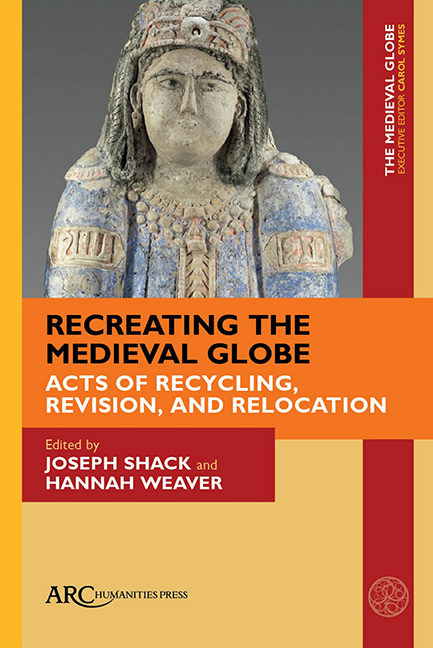Book contents
- Frontmatter
- Contents
- List of Illustrations
- Introduction to Recreating the Medieval Globe: Acts of Recycling, Revision, and Relocation
- Self-Revision and the Arabic Historical Tradition: Identifying Textual Reuse and Reorganization in the Works of al-Balādhurī
- When Curtains Fall: A Shape-Shifting Silk of the Late Abbasid Period
- Salvaging Meaning: The Art of Recycling in Sino-Mongol Quanzhou, ca. 1276–1408
- Recontextualizing Indigenous Knowledge on the Prussian–Lithuanian Frontier, CA. 1380–1410
- Meubles: The Ever Mobile Middle Ages
- Reflection
- Index
Reflection
Published online by Cambridge University Press: 22 June 2021
- Frontmatter
- Contents
- List of Illustrations
- Introduction to Recreating the Medieval Globe: Acts of Recycling, Revision, and Relocation
- Self-Revision and the Arabic Historical Tradition: Identifying Textual Reuse and Reorganization in the Works of al-Balādhurī
- When Curtains Fall: A Shape-Shifting Silk of the Late Abbasid Period
- Salvaging Meaning: The Art of Recycling in Sino-Mongol Quanzhou, ca. 1276–1408
- Recontextualizing Indigenous Knowledge on the Prussian–Lithuanian Frontier, CA. 1380–1410
- Meubles: The Ever Mobile Middle Ages
- Reflection
- Index
Summary
THE PREMONSTRATENSIAN ABBEY of Dryburgh, located on the banks of the River Tweed just a few miles downstream from Sir Walter Scott's home at Abbotsford, is a hauntingly beautiful site in the late autumn when the leaves are changing colour. Like its sister abbeys in the Scottish Borders—Kelso, Jedburgh, and nearby Melrose—Dryburgh was burned and sacked at regular intervals over the centuries by English troops engaged in cross-border raids. Following the sack that took place in the mid-sixteenth century, at a time when the Scottish Reformation made sources of patronage scarce, the monks simply gave up. Today, Dryburgh is a romantic old ruin, the roofless nave of the abbey church now a beautiful and verdant lawn. Given the extent of the decay, it is surprising how little remains in the way of rubble. Some explanation for this is provided by way of a plaque, mounted next to the western portal, which makes an apology for the sorry condition of the adjoining façade. At some point in the past, much of the original facing had been “robbed,” leaving only the rough-hewn and much-eroded local sandstone that you now see.
Only in the eyes of today's resentful conservator is it possible to speak of the thrifty and practical reuse of worked stone as a kind of robbery. As any early medieval archaeologist can attest, the bricks and stones that once comprised the fabric of the Roman world were removed and distributed across the landscape, where they were fitted into homes and barns and kilns. Much the same happened to Dryburgh and its sister abbeys, and indeed with worked stone virtually everywhere. For the time being, Dryburgh is safe: Historic Scotland frowns on the recycling of stone at sites ranging from great abbeys to the old crofts that still litter the Scottish highlands. The policy is well intentioned. It has had the unfortunate effect, however, of preserving one element of the past at the expense of disparaging another: namely, the ancient practice of recycling.
The reuse of worked stone or brick is one of an innumerable array of processes that make it possible to prolong the lifespan of elements of the material world.
- Type
- Chapter
- Information
- Recreating the Medieval GlobeActs of Recycling, Revision, and Relocation, pp. 155 - 162Publisher: Amsterdam University PressPrint publication year: 2020

